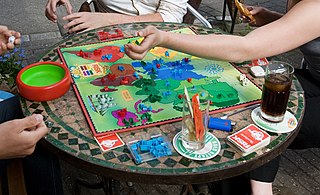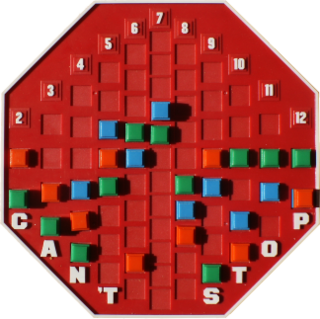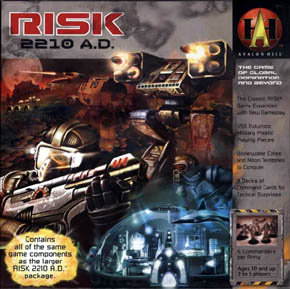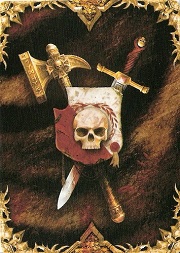
Risk is a strategy board game of diplomacy, conflict and conquest for two to six players. The standard version is played on a board depicting a political map of the world, divided into 42 territories, which are grouped into six continents. Turns rotate among players who control armies of playing pieces with which they attempt to capture territories from other players, with results determined by dice rolls. Players may form and dissolve alliances during the course of the game. The goal of the game is to occupy every territory on the board and, in doing so, eliminate the other players. The game can be lengthy, requiring several hours to multiple days to finish. European versions are structured so that each player has a limited "secret mission" objective that shortens the game.

Can't Stop is a board game designed by Sid Sackson originally published by Parker Brothers in 1980; however, that edition has been long out of print in the United States. It was reprinted by Face 2 Face Games in 2007. An iOS version was developed by Playdek and released in 2012. The goal of the game is to "claim" three of the columns before any of the other players can. But the more that the player risks rolling the dice during a turn, the greater the risk of losing the advances made during that turn.

Risk 2210 A.D. is a 2–5 player board game by Avalon Hill that is a futuristic variant of the classic board game Risk. Risk 2210 A.D. was designed by Rob Daviau and Craig Van Ness and first released in 2001. In 2002, it won the Origins Award for "Best Science Fiction or Fantasy Board Game of 2001".

Conquest of the Empire is a military strategy board game set in the Roman Empire after the death of Marcus Aurelius, with 2 to 6 players pitting their armies against each other in an attempt to become the ruler of Rome. The game was created in 1982 by Larry Harris and published by The Citadel under the title VI Caesars. Harris revised the game for Milton Bradley in 1984 to be reissued under the title Conquest of the Empire as part of the Gamemaster series. The game was re-released in the summer of 2005 by Eagle Games, redesigned by Glenn Drover. The gameplay in Conquest of the Empire shares similarities to Axis & Allies, another Larry Harris project within the same series.

History of the World is a board game designed by Ragnar Brothers and originally published in 1991. It is played by up to six players across various epochs, each player playing a different empire every round to have the greatest score at the end of the game by conquering other players' regions of the board.

Greyhawk Wars is a fantasy board wargame that was published by TSR, Inc. in 1991. The game was designed by David Cook as a strategic simulation of the eponymous Greyhawk Wars on the fictional world of Oerth, the World of Greyhawk campaign setting for the Dungeons & Dragons role-playing game.

Empires in Arms is an out-of-print board game by Harry Rowland, published by the Australian Design Group in 1983. It was licensed to the Avalon Hill Game Company in 1985.
Star Wars Risk: The Clone Wars Edition is a form of the board game Risk. The factions represented in the game are the Galactic Republic, led largely by the Jedi, and the Separatists, led by charismatic Count Dooku.

Wallenstein is a medium-weight German-style board game designed by Dirk Henn and published by Queen Games in 2002. Though set during the Thirty Years' War, Wallenstein should not be confused with a complex wargame. Rather, it has the feel of a light strategy game with the familiar Euro elements of area control and resource management mixed in. As such, it has a wide range of appeal that attracts wargamers and non-wargamers alike.

Supremacy: The Game of the Superpowers is a political, economical, and military strategic board wargame published in 1984 by Supremacy Games, and designed by Robert J. Simpson.

Shogun is a strategy board game designed by Dirk Henn and published by Queen Games in 2006. It is based on his earlier game Wallenstein, but it is set in the Sengoku period, which ends with the inception of the Tokugawa Shogunate.

Dune is a strategy board game set in Frank Herbert's Dune universe, published by Avalon Hill in 1979. The game was designed by Bill Eberle, Jack Kittredge and Peter Olotka. After many years out of print, the game was reissued by Gale Force Nine in 2019 in advance of the 2021 Dune film adaptation.

Risk: Star Wars Original Trilogy Edition is a commercial strategic board game, produced by Parker Brothers, a division of Hasbro. It is a variation of the classic board game Risk, with the rules and appearance altered to fit within the fictional Star Wars universe, during the Galactic Civil War period. It was released in November 2006, almost two years after the release of Star Wars Risk: The Clone Wars Edition.

Imperial is a German-style board game designed by Mac Gerdts in which the object is to accumulate wealth in the form of bond holdings in successful countries and cash. Players take on the role of international financiers who purchase government bonds in the six pre-World War I empires of Austria-Hungary, France, Germany, Great Britain, Italy, and Russia. The principal bondholder of a nation gains control of its government and can order importation or production of armaments and ships; maneuvering of military units; construction of factories; and taxation. During play, an investor card is passed around which allows the purchase of additional bonds. A rondel – a wheel-shaped game mechanism with eight different options – is used to determine the options available to a country. The game box states that it is for 2–6 players, but a developer-supported variant allows play with seven. Imperial 2030 is a follow-up game released in 2009 with similar mechanics.

Warrior Knights is a board game for 2–6 players originally published by Games Workshop in 1985, and later published by Fantasy Flight Games in 2006. Each player takes the role of a Baron vying to claim the throne of an unnamed kingdom. Gameplay revolves around raising an army, obtaining enough money to maintain that army, and gaining influence through a variety of means.

Warhammer: Invasion is a Living Card Game (LCG) designed by Eric M. Lang and produced by Fantasy Flight Games in 2009, set in the Warhammer Fantasy universe. Like Fantasy Flight's other LCGs, Invasion is sold as a core set, which can be played on its own, or built upon with expansion packs. Each pack has a fixed set of 3 copies each of 20 cards. There are six factions in Invasion: Dwarves, Empire, Orcs, Chaos, High Elves, and Dark Elves. The first four have decks in the core set, while the elves' decks are available in the Assault on Ulthuan expansion.
Age of Napoleon is a 2003 war and strategy board game created in collaboration between Mayfair Games and Phalanx Games. It focuses on the Napoleonic Wars in Europe from 1805 to 1815. The game's designer is Renaud Verlaque and its artist is Franz Vohwinkel.

RisiKo! is an Italian strategy board game based on Risk. Unlike Risk, the object of the game is the achievement of a predefined, secret target that is different for each player: the target can be either the conquest of a certain number of territories, of two or more continents, or the annihilation of one opponent.

COIN is a series of multiplayer asymmetric strategy board wargames simulating historic insurgency and counter-insurgency conflicts and irregular warfares throughout the world. It is published by GMT Games.















